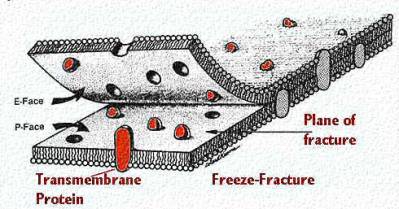The freeze-fracture/freeze etch technique starts with rapid freezing of a cell. Then the frozen cells are cleaved along a fracture plane. This fracture plane is inbetween the leaflets of the lipid bilayer , as shown by this cartoon. The two fractured sections are then coated with heavy metal (etched) and a replica is made of their surfaces. This replica is then viewed in an electron microscope. One sees homogeneous regions where there was only the exposed lipid leaflet (Is the exposed surface made of polar or nonpolar groups? This figure was modified from Bloom and Fawcett, A Textbook of Histology, Chapman and Hall, N.Y., Twelfth Edition, 1994, Figure 1-3. Consult the section on Membrane Architecture for the answer.)

In certain areas of the cell, one also sees protrusions or bumps. These are colored red in the cartoon. Sometimes one can see structure within the bumps themselves. These are the transmembrane proteins.
The following illustrations will show you some views of specialized regions in the membrane. The organization or structure of the transmembrane proteins can be visualized.




